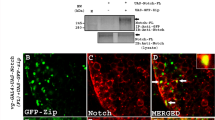Summary
The molecular nature of lethal and semilethal mutations in the Pgd locus of D. melanogaster coding for 6-phosphogluconate dehydrogenase (6PGD) was studied. All the 11 mutations affect the structural gene of the Pgd locus: 3 semilethal mutations resulted in altered 6PGD molecules with decreased catalytic activities; the rest 8 lethals were “null” alleles characterized by mutant polypeptides capable of reacting with antisera against highly purified 6PGD.
“Null” or low activity alleles for glucose-6-phosphate dehydrogenase induced by ethyl methanesulfonate were shown to be suppressors for the lethal mutations in the Pgd locus.
A monocistronic type of organization of the Pgd locus is suggested taking into account the biochemical mechanism of suppression of the Pgd-lethals and their location in the structural gene coding for 6PGD.
Similar content being viewed by others
References
Abrahamson, S., Bender, M.A., Conger, A.D., Wolf, C.: Uniformity of radiation induced mutation rates among different species. Nature (Lond.) 245, 460–462 (1973)
Ananiev, E.V., Barsky, V.E.: DNA content, replication and transcription rate in different sites of the X-chromosome of D. melanogaster. Molec. Biologia (Russ.) 9, 752–760 (1975)
Auerbach, C., Kilbey, B.J.: Mutations in eukaryotes. Ann. Rev. Genet. 5, 163–218 (1971)
Bahn, E.: A suppressor locus for the pyrimidine requiring mutant: rudimentary. Dros. Inform. Service 49, 98 (1972)
Beermann, W.: Chromomeres and genes. In: Results and problems in cell differnetiation, Vol. 4, pp. 1–33. Berlin-Heidelberg-New York: Springer (1973)
Bewley, G.C., Lucchesi, J.C.: Lethal effects of low and “null” activity alleles of 6-phosphogluconate dehydrogenase in D. melanogaster. Genetics 79, 451–457 (1975)
Bishop, J.B., Lee, W.R.: Chromosome breakage in D. melanogaster induced by a monofunctional alkylating agent (EMS). Mutation Res. 21, 327–333 (1973)
Brenner, S.: The genetics of Caenorhabditis elegans. Genetics 77, 71–94 (1974)
Davidson, E.H., Britten, R.J.: Organization, transription, and regulation in the animal genome. Quart. Rev. Biol. 48, 565–613 (1973)
Gelbart, W.M., McCarron, M., Pandey, J., Chovnick, A.: Genetic limits of the xanthine dehydrogenase structural elements within the rosy locus in D. melanogaster. Genetics 78, 869–886 (1974)
Georgiev, G.P.: On the structural organization of operon and the regulation of RNA synthesis in animal, cells. J. theor. Biol. 25, 473–490 (1969)
Gvozdev, V.A., Birstein, V.J., Faizullin, L.Z.: Gene dependent regulation of 6-phosphogluconate dehydrogenase activity of Drosophila melanogaster. Molec. Biologia (Russ.) 6, 876–887 (1970)
Gvozdev, V.A., Gerasimova, T.I., Kogan, G.L., Braslavskaya, O.Yu.: Role of the pentose phosphate pathway in metabolism of Drosophila melanogaster elucidated by mutations affecting glucose-6-phosphate and 6-phosphogluconate dehydrogenases. FEBS Letters 64, 85–88 (1976)
Gvozdev, V.A., Gostimsky., S.A., Gerasimova, T.I., Dubrovskaya, E.S., Braslavskaya, O.Yu.: Fine genetic structure of the 2D3–2F5 region of the X-chromosome of D. melanogaster. Mol. gen. Genet. 141, 269–275 (1975)
Hartman, P.E., Hartman, Z., Stahl, R.C., Ames, B.: Classification and mapping of spontaneous and induced mutations in the histidin operon of Salmonella. Advanc. Genet. 16, 1–34 (1971)
Hartman, P.E., Roth, J.R.: Mechanisms of suppression. Adv. in Genet. 17, 1–106 (1973)
Judd, B.H., Shen, M.W., Kaufman, T.C.: The anatomy and function of a segment of the X-chromosome of D. melanogaster. Genetics 71, 139–156 (1972)
Kazazian, H.H., Young, W.J., Childs, B.: X-linked 6-phosphogluconate dehydrogenase in Drosophila: Subunit association. Science 150, 1601–1602 (1965)
Kazazian, H.H.: Molecular size studies in 6-phosphogluconate dehydrogenase. Nature (Lond.) 212, 197–198 (1966)
Kogan, G.V., Rosovsky, Ya. M., Gvozdev, V.A.: Purification and immunological characteristics of the wild type and mutant forms of 6PGD. Molec. Biologia (Russ.). in press
Lefevre, G.: The relationship between genes and polytene chromosome bands. Ann. Rev. Genet. 8, 51–62 (1974)
Lehninger, A.L.: Biochemistry. New York: Worth publishers 1972
Lindsley, D.L., Grell, E.H.: Genetic variations of Drosophila melanogaster. Carnegie Inst. Wash. Publ. 627 (1968)
Luzzatto, L.: Genetic heterogeneity and pathophysiology of glucose-6-phosphate dehydrogenase deficiency. Brit. J. Haematol. 28, 151–155 (1974)
Olenov, Yu. M.: On the genome organization in Metazoa. Cytologia (Russ.) 16, 403–418 (1974)
Ouchterlony, O.: Antigen-antibody reactions in gels. IV. Types of reactions in coordinated systems of diffusion. Acta. Path. Microbiol. Scand. 32, 231–240 (1953)
Parr, C.W.: Inhibition of phosphoglucose isomerase. Nature (Lond.) 178, 1401 (1956)
Rawls, J.M., Fristrom, J.W.: A complex genetic locus that controls the first three steps of pyrimidine biosynthesis in Drosophila. Nature (Lond.) 255, 738–740 (1975)
Schalet, A.P., Sankaranarayanan, K.: Evaluation and re-evaluation of genetic radiation hazards in man. I. Interspecific comparison of estimates of mutation rates. Mutation Res. 35, 341–370 (1976)
Schawartz, M., Sofer, W.: Alcohol dehydrogenase-negative mutants in Drosophila: Defects at the structural locus? Genetics 83, 125–136 (1976)
Wahl, G.M., Hughes, S.H., Capecchi, M.D.: Immunological characterization of hypoxanthine-guanine phosphorybosyl transferase mutants of mouse L cells: evidence for mutations at different loci in the HGPRT gene. J. Cell Physiol. 85, 307–320 (1975)
Wasserman, E., Levine, L.: Quantitative micro-complement fixation and its use to study of antigenic structure by specific antigen-antibody inhibition. J. Immunol. 87, 290–295, (1961)
Wright, D.A., Shaw, C.R.: Time of expression of genes controlling specific enzymes in Drosophila embryos. Biochem. Genet. 4, 385–394 (1970)
Author information
Authors and Affiliations
Additional information
Communicated by Ch. Auerbach
Rights and permissions
About this article
Cite this article
Gvozdev, V.A., Gerasimova, T.I., Kogan, G.L. et al. Investigations on the organization of genetic loci in Drosophila melanogaster: lethal mutations affecting 6-phosphogluconate dehydrogenase and their suppression. Molec. Gen. Genet. 153, 191–198 (1977). https://doi.org/10.1007/BF00264735
Received:
Issue Date:
DOI: https://doi.org/10.1007/BF00264735




